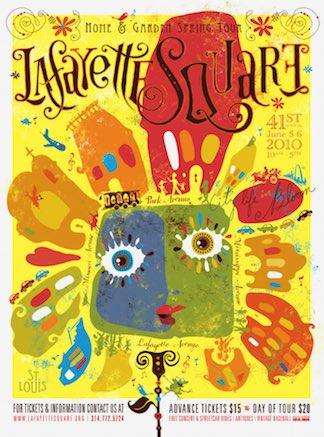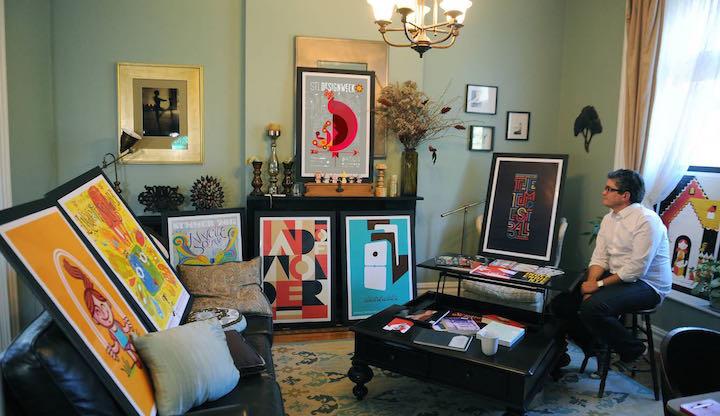The DART Q&A: Carlos Zamora
Q: Originally from Cuba, what are some of your favorite things about living and working in St. Louis?
A: I was born in 1976 in Cuba. I graduated from the Design School in La Habana and left my country when I was 27. I followed a ballerina that was visiting La Habana to Quito, Ecuador in 2003. After a year of dating she confessed she was a psychotherapist taking a break in Cuba. We lived in Ecuador for 2 ½ years and then moved to St. Louis in 2006.
My hometown, Sancti Spiritus is a colonial village founded in 1514. My house in Cuba is located two blocks from the central park, the library and the Yayabo River. It is old, with high ceilings and stained glass windows above the doors that take you to a patio with a mango tree in the middle. My Victorian house in St. Louis is located on Lafayette Square -two blocks from Lafayette Park, four blocks from a public library, and 5 minutes away from the Mississippi River. I have everything a man could need to be happy, except the mango tree. It is really a magical place in St. Louis. What I like the most about my adopted city is its unresolvedness. It is a city conflicted with its past and that presents a lot of opportunities for engagers outsiders, like me. Notice the shrink-talk. The art scene is quite nice, and it is a great place to raise a family.
Q: Do you keep a sketchbook? What is the balance between the art you create on paper versus in the computer?
A: Several. I have tons of them for different purposes, ideas, assignments, cigar labels—I’m a cigar fan, Cubans or not. I sketch everything. Sometimes I scan the sketches and continue working on the computer and sometimes I sketch on the computer. I have a Wacom tablet that changed my process in 2010 and I never went back. It really expedites things. I’m very methodical and process oriented. My brain is a Gestalt-Bau Haus machine. I have to admit I’m scared of expensive art materials. Growing poor in art resources in a country like Cuba makes you afraid of expensive art materials. They sort of paralyze me. But my Wacom makes everything looks nice and tight. I don’t have a possessive approach to art. I don’t necessarily feel the need to create a thing people cherish. The important thing for me is the concept and how touches people. That’s why posters are the highest form of art and design for me. They capture a moment, they inspire action, and they are mass-produced. Poster is art for all. I highly respect that.
Q: What do you like best about your workspace? Do you think it needs improvement, if so, what would you change?
A: I’m in a transition period. Currently my studio is in my living room, it used to be on the third floor. The light was perfect, but I felt very disconnected from the rest of the house. My two daughters are growing up fast and I missed all the action taking a place on the first floor. So I moved into the chaos of homework, dinners and distractions, which I secretly love. My daughters influence my process a lot. They are very opinionated and witty. Sometimes I let them pick colors or correct my rhymes in the children’s books that I write. The girls are bilingual and are always making fun of my accent and grammar mistakes. I am soon moving my studio into their current room downstairs and they will have their room on the third floor. So… I just realized I have moved my studio all over the house. I guess I’m still trying to find my place in my own house. Same thing happens with my illustration style: it moves all over from rational shapes from Russian constructivism to whimsical Victorian free-hand style. Neither my styles, nor my studio are settled yet.
Q: What is the most important item in your studio?
A: Little treasures from previous lives. As an immigrant I have a collection of objects that connect me with people I love, or once loved. I would say that my most precious item is an illustrated edition of Alekandr Nikoalevich’s Basilisa La Hermosa - a Russian book of fantastic folk tales, from my childhood. The illustrations are both macabre and whimsical. It is a very powerful book from a former Soviet publishing house named Raduga [Rainbow]. I stole it from a girl I was in love with when I was 9 years old.

A: I know it is done when the piece makes me stare at it and wander through it. When it feels like it has such a live of its own, that doesn’t belong to me. It is its own thing. I do a lot of poster design for events, festivals and fundraisers. I know a poster is finished when there is a balance, and every element in the poster justifies its existence in the composition through graphic tension, that it is precise and effortlessly invisible.
Q: What was your favorite book as a child? What is the best book you’ve recently read?
La Gallinita Negra y el Reino Subterraneo [The Black Hen and the Underground World] by Antony Pogorelski. This is a superb picture book with a very intricate story that takes place in St. Petersburg. The story was first published in 1829. An orphan kid gets access to a world of gnomes and fantastic creatures after saving a magic black hen. The answer to the second question is kind of odd. I recently finished Ayn Rand’s biography. She was originally also from St. Petersburg. I’m not an Ayn Rand’s fan at all, but her Objectivism’ doctrine helped me understand a lot of things about the Cuban-American conflict and why Americans are so weird about Communism. As a Cuban kid in 80’s, my childhood –and the whole country- was under the Russian influence: cartoons, literature, and communist propaganda. I didn’t know better. It wasn’t as bad as it sounds.
Q: If you had to choose one medium to work in for an entire year, eliminating all others, what medium would you choose?
A: Charcoal. I would like to explore charcoal’s humility and get messy. No color allowed. Just charcoal, raw blackness on nice paper.
Q: If you could time travel to any era, any place, where would you go?
A: Cuba, May 20, 1902. The day Cuba became a Republic after four centuries of colonialism. I’m obsessed with that Art Deco era –Havana’s Belle Epoque. There’s a lot in those years that we will need to revisit as the country redefines the future of Cuban-American relations.
Q: What is preoccupying you at the moment?
A: Balance. Building a career as an illustrator, while raising a family in the US and supporting my family in Cuba. I like to make sure everybody has what they need in order to thrive. All of that is doable, but kind of insane. It really motivates me to do more, but it does get wacky sometimes. I also live in a family full of smart, thought provoking, loving women. They are from all over the world, and each of them has their own personalities and idiosyncrasies. My wife, Juliana is from Venezuela, raised in US. My first daughter, Aitana was born in Quito, Ecuador and my second daughter, Lucía was born in St. Louis. My sister Liz is from Cuba. Then, I also have my mother-in-law Mabel from Uruguay and her mother Perla from Uruguay/Italy. Did I mention our female dog Luna? They are all awesome, but sometimes they drive me nuts. I did not forget my Polish agent Ella Lupo – she is the toughest. Ha!
Q: What are some of your favorite places/books/blogs/websites for inspiration?
A: The Society of Illustrators, AI-AP (I really enjoy The DART Q&A section), AIGA.org, the blog Design Envy, Monocle Magazine, UK radio. I find a lot of inspiration in people I admire and have influenced my career: Isidro Ferrer, Kiku Obata, Edel Rodríguez, Pepe Menéndez, Nelson Ponce, Alfredo Rostgaard, Milton Glaser. I love NYC. I love La Habana but I can’t live there. It’s too painful. I like the solid permanence of the Midwest. Also, special places and details in the Central West End neighborhood in Saint Louis: the International Chess Hall of Fame, the stain-glass work at the ceiling in The Tenderloin Room at the Chase Park Plaza, Brennan’s—a cigar lounge where everything gets aligned in my head.
Last, but not least: Lafayette Park—where my daughter Aitana found a tree that takes her to “The Robot’s Factory” or “Fairyland”—a special part of the park where there is a small lake under a bridge where my daughter Lucía likes to take us “to be bad” —meaning have ice cream in pajamas, candy and all sort of sweets at 9pm. There’s no place in world like Fairyland.
Q: What was the [Thunderbolt] painting or drawing or film or otherwise that most affected your approach to art?
A: It was actually an old calligraphy manual a friend of my grandmother gave me when I was in kindergarten. I remember I was fascinated with the ornaments in the letters and I started drawing initial letters, before knowing how to read: letters where just shapes—pure form with no meaning.
Also the moment I realized that the story arc of Alice Through the Looking Glass was made of actual chess moves—with Alice as a pawn that becomes Queen at the end. That discovery was quite remarkable.
Q: What would be your last supper?
A: Ropa Vieja. No doubt. A Cuban dish made of shredded meat in tomato sauce, white rice, “sleepy black beans,” fried green plantains, yucca with olive oil, tons of garlic and lemon, Hatuey beer, guava marmalade and cream cheese.
Carlos Zamora is a Creative Director at Express Scripts—a Fortune 20 company that makes the use of prescription drugs safer and more affordable to people. He is a former President of AIGA St. Louis. He cherishes a fondness for poster design, Russian cartoons and propaganda art. He can often be found at Brennan’s Cigar Lounge daydreaming about his next poster show and plotting all sorts of revolutions. His illustrations have been published by the New York Observer, The Boston Globe, Advertising Age Magazine, American Lawyer, the Wall Street Journal. Some of his work this year has been included in American Illustration 34 and Society of Illustrators 58th.
Zamora was at the poster exhibition in the Fábrica de Arte Cubano, during the first Havana Design Biennial in May 2016. Look for his poster for the 50th Anniversary of the Mostly Mozart Festival at The Lincoln Center in NYC this summer. He is honored to be a judge at the Latin American Illustración Show No. 5 at AI-AP coming up this fall.
Website: carloszamora.com
Agent: Ella Lupo, Purple Rain Illustrators
purplerainillustrators.com
Subscribe to DART: Design Arts Daily here





